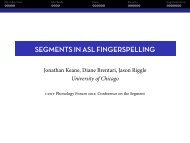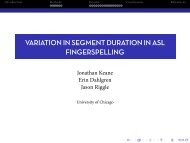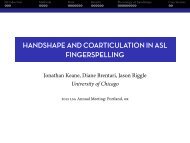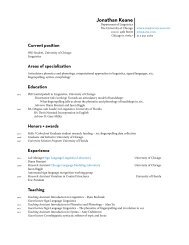Handshape assimilation in ASL fingerspelling ... - Jonathan Keane
Handshape assimilation in ASL fingerspelling ... - Jonathan Keane
Handshape assimilation in ASL fingerspelling ... - Jonathan Keane
- No tags were found...
Create successful ePaper yourself
Turn your PDF publications into a flip-book with our unique Google optimized e-Paper software.
Introduction Methods Ulnar Flexion ConclusionsSelected f<strong>in</strong>ger quantity <strong>assimilation</strong>Push<strong>in</strong>g the boundariesBecause of underspecification, handshapes that have [all] f<strong>in</strong>gersselected should be more susceptible to <strong>assimilation</strong>.Of the [all] f<strong>in</strong>gers selected handshapes:▸ -E- and -O- show variation.▸ -A- and -S- show no variation, but all f<strong>in</strong>gers completely flexed.▸ -C- shows little variation, but this could be physiological, (CFlexical handshape contours).▸ -B- (seem<strong>in</strong>gly) shows no variation, has all f<strong>in</strong>gers extended, thismight be physiological or phonological block<strong>in</strong>g (EG -U-).









